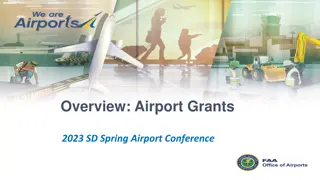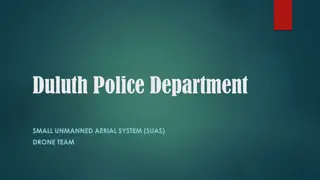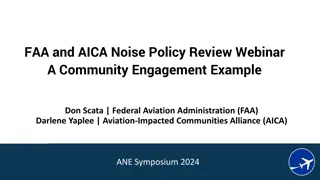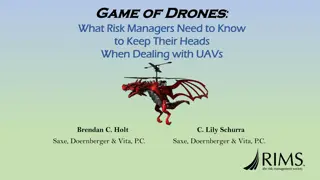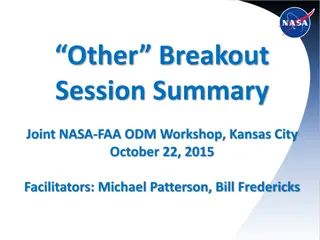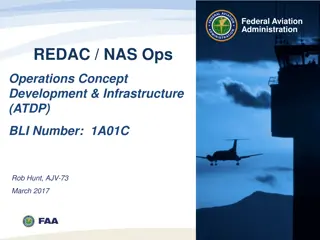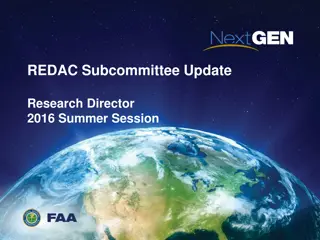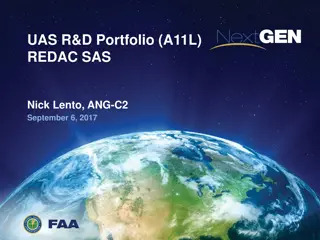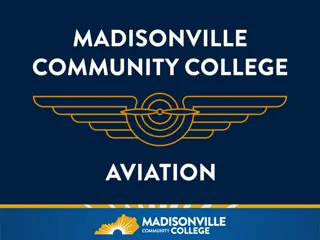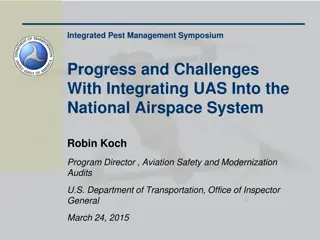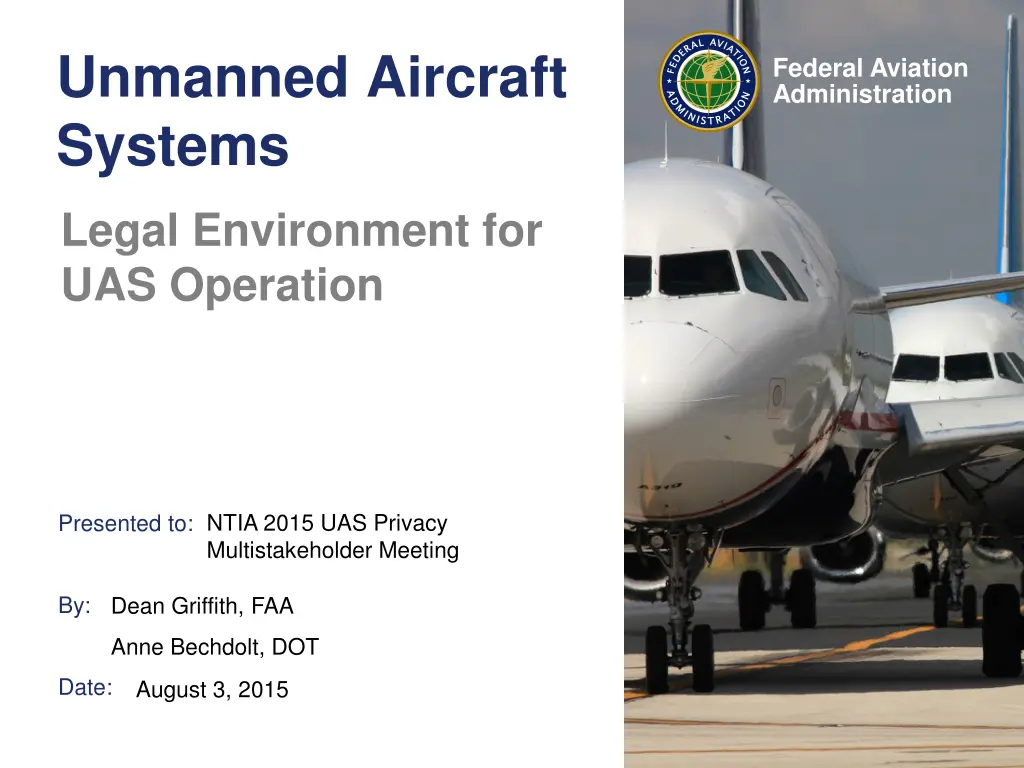
Federal Aviation Administration Overview: UAS Operation and Regulations
Explore the legal environment and operational aspects of Unmanned Aircraft Systems (UAS) as presented by the Federal Aviation Administration (FAA). Learn about FAA's safety priorities, UAS definitions, jurisdiction, civil aircraft operations, and current methods of UAS operations.
Download Presentation

Please find below an Image/Link to download the presentation.
The content on the website is provided AS IS for your information and personal use only. It may not be sold, licensed, or shared on other websites without obtaining consent from the author. If you encounter any issues during the download, it is possible that the publisher has removed the file from their server.
You are allowed to download the files provided on this website for personal or commercial use, subject to the condition that they are used lawfully. All files are the property of their respective owners.
The content on the website is provided AS IS for your information and personal use only. It may not be sold, licensed, or shared on other websites without obtaining consent from the author.
E N D
Presentation Transcript
Unmanned Aircraft Systems Federal Aviation Administration Legal Environment for UAS Operation NTIA 2015 UAS Privacy Multistakeholder Meeting Presented to: By: Dean Griffith, FAA Anne Bechdolt, DOT Date: August 3, 2015
Aviation Safety is FAAs Priority The FAA has the responsibility to maintain the safety of the NAS and people and property on the ground. We have a plan for safe and staged integration. We are making progress to achieve that goal. Federal Aviation Administration 2
What Are Unmanned Aircraft ? Unmanned Aircraft - An aircraft that is operated without the possibility of direct human intervention from within or on the aircraft. Unmanned Aircraft System - An unmanned aircraft and associated elements . . . that are required for the pilot in command to operate safely and efficiently in the National Airspace System. Sec. 331, P.L. 112-95, Feb. 14, 2012 Federal Aviation Administration 3
FAA Jurisdiction Definition of Aircraft 49 U.S.C. 40102(a)(6) defines an aircraft as any contrivance invented, used, or designed to navigate or fly in the air. 14 C.F.R. 1.1 defines an aircraft as a device that is used or intended to be used for flight in the air. Federal Aviation Administration 4
FAA Jurisdiction General authority to promote safe flight of civil aircraft in air commerce. 49 U.S.C. 44701 Authority to prescribe air traffic regulations to protect aircraft and people and property on the ground. 49 U.S.C. 40103(b) Regulatory authority from the ground up. Existing rules allow aircraft operations below 500 (14 C.F.R. 91.119). Federal Aviation Administration 5
Civil Aircraft Operations Requirements Certificated Aircraft (49 U.S.C. 44711) Standard Airworthiness Certificate (TC/PC) Special Airworthiness Certificate Restricted Experimental 14 C.F.R. parts 21-39 Certificated Pilot (49 U.S.C. 44711) 14 C.F.R. part 61. Registered Aircraft (49 U.S.C. 44101) Federal Aviation Administration 6
Current Ways to Operate UAS Public Aircraft Operation + COA Certificated Aircraft + COA May need exemption. Section 333 Determination + Exemption + COA Model Aircraft Section 336 Sections 333 and 336 created by the 2012 FAA Modernization and Reform Act (P.L. 112-95) Federal Aviation Administration 7
Section 333 Operations Operators must adhere to conditions in the exemption and COA, including: Daytime operations only. Must stay 500 from non-participants. Must have permission from the property owner or someone with authority to grant access. No higher than 400 above ground level. Most below 200 . Within line of sight of the operator. COAs require issuance of NOTAM. Aircraft registered and marked. Federal Aviation Administration 8
Model Aircraft Sec. 336 Key Characteristics. Hobby or recreational. Visual line of sight of the operator. Within Community Based Organization safety guidelines and programming. Give way to manned aircraft. Notify airports and air traffic control towers w/in 5 mi. Do not need FAA authorization. Not subject to future FAA rulemakings. May be subject to general rules applicable to all aircraft such as airspace rules. Federal Aviation Administration 9
Summary of Current Operations Public aircraft Wide range of government entities currently flying diverse kinds of operations. Civil aircraft FAA authorized Arctic operations. Limited commercial operations authorized under 333 process. More than 1,000 to date. Model aircraft Test Sites All 6 test sites operating. Federal Aviation Administration 10
Proposed Small UAS Rule Will open the door to non-recreational operations. Including commercial, research, educational use. Highlights of Proposed Requirements: UA less than 55 pounds. Within line of sight of operator. Maximum 500 above ground level. Daytime. Not over people. Pilot certificate Knowledge test. Aircraft registered and marked. FAA is reviewing public comments. Federal Aviation Administration 11
Contacts/Resources Dean Griffith, Office of the Chief Counsel, FAA: dean.griffith@faa.gov Anne Bechdolt, Office of the General Counsel, DOT: anne.bechdolt@dot.gov www.faa.gov/uas Small UAS NPRM 80 Fed. Reg. 9544 (Feb. 23, 2015) Docket No. FAA-2015-0150 (www.regulations.gov) Federal Aviation Administration 12


